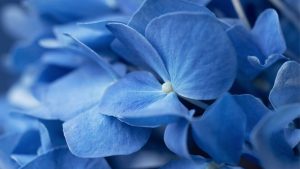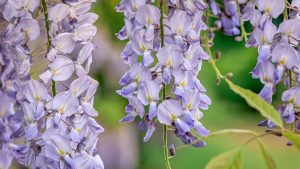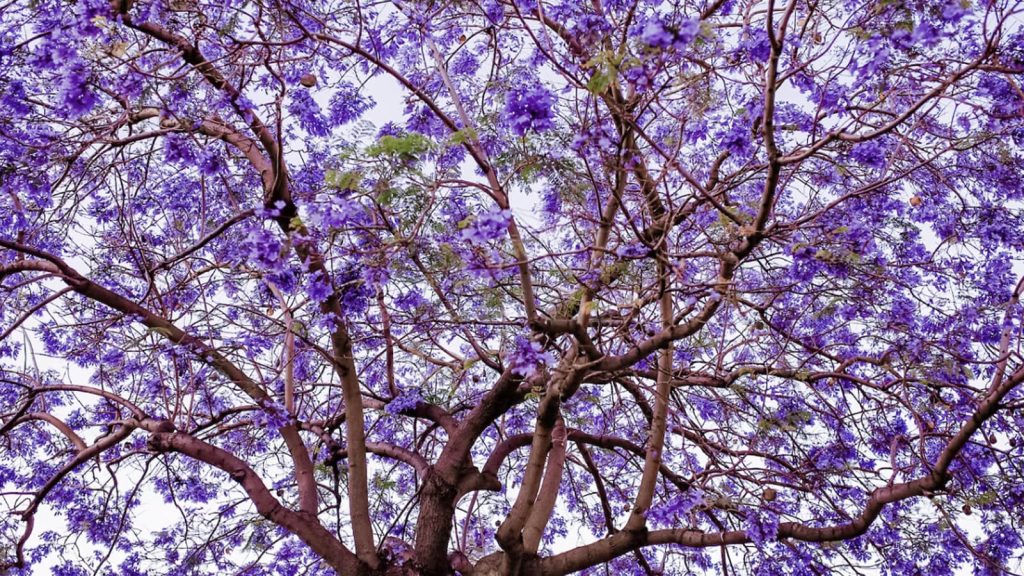Blue wisteria, also known as Wisteria sinensis ‘Blue Moon’ or Chinese wisteria ‘Blue Moon,’ is a beautiful and ornamental flowering vine, not a tree. However, it often grows on trellises, arbors, or pergolas, creating a tree-like appearance. This stunning plant is cherished for its cascading clusters of fragrant, bluish-purple flowers and lush green foliage. While there are several species of wisteria, the two most commonly cultivated are the Chinese wisteria (Wisteria sinensis) and the Japanese wisteria (Wisteria floribunda). Here is a conclusive overview of the blue wisteria:
Botanical Characteristics of Blue Wisteria:
Blue wisteria belongs to the Wisteria genus within the Fabaceae family. It is native to China and has become a popular ornamental plant in various parts of the world.
Appearance:
This vine produces elegant, pinnate leaves consisting several smaller leaflets. Its most distinctive feature is the long, drooping clusters of pendulous, pea-like flowers. These flowers are typically a soft shade of bluish-purple, giving the plant its “Blue Moon” moniker.
Fragrance:
Blue wisteria is renowned for its sweet, intoxicating fragrance, which attracts pollinators like bees and butterflies. The scent creates a delightful atmosphere in gardens and outdoor spaces. It is popular among gardeners and outdoor enthusiasts since the scent is characterized frequently as a combination of honey, lavender, and lilac.

Cultivation of Blue Wisteria:
Choose a sunny location with well-draining soil to cultivate a blue wisteria. It requires regular pruning to control its growth and encourage flowering. The vine will vigorously grow. Proper care is essential to maintain its shape and appearance.
Seasonal Beauty:
Blue wisteria typically blooms in late spring to early summer, producing a profusion of flowers that create a mesmerizing waterfall effect. Wisteria is renowned for its breathtaking cascades of flowers. The pendulous, pea-like blossoms form long, drooping clusters that vary in color, with popular shades including violet, lavender, pink, and white. These showy blooms create a mesmerizing spectacle when in full bloom, often covering the entire vine with a waterfall of color. The sight of these cascading blossoms is a favorite among garden enthusiasts.
Symbolism:
In many cultures, wisteria is associated with qualities such as, longevity, beauty, and love. . In Japan, it represents love and sensuality and is associated with the changing seasons. In Chinese culture, wisteria symbolizes humility and respect for elders. Its presence in gardens often signifies the passage of time and the fleeting nature of beauty.
Versatile Use:
While not a tree itself, blue wisteria is trained to grow as a tree-like form by attaching it to a sturdy support structure. It is also used to enhance fences, walls, and pergolas, adding an enchanting touch to outdoor spaces.
Vigorous Growth:
Wisteria is known for its rapid growth and climbing ability. It quickly cover trellises, arbors, pergolas, and walls, providing a lush and natural shade source. The vine’s vigorous growth makes it an excellent choice for creating privacy or adding aesthetic appeal to a garden or outdoor space.
Maintenance:
Proper care and maintenance is required. Regular pruning to remove dead or excess growth is essential for a healthy and thriving blue wisteria. This ensures a more manageable and aesthetically pleasing appearance.
Here is a comprehensive overview of wisteria and its potential tree-like form:
1. Wisteria Species: The Fabaceae family of flowering plants includes the genus Wisteria. The two most frequently cultivated species for their ornamental appeal are Wisteria sinensis (Chinese wisteria) and Wisteria floribunda (Japanese wisteria).
2. Cultural Significance: Wisteria has cultural significance in various regions and symbolizes qualities such as, longevity, beauty, and the changing seasons. Its stunning flowers and enchanting fragrance make it a popular choice for gardens and landscapes
3. Growing Conditions: Wisteria thrives in full sun and well-drained soil. Adequate support, such as a trellis or arbor, is essential for training it into a tree-like shape. Regular pruning is also necessary to maintain the desired form and encourage flowering.
4. Bloom Time: Depending on the species and local temperature, wisteria often blooms in the spring or early summer. The blossoms produce spectacular display of color and scent.
5. Attracting Pollinators: Wisteria attracts pollinators like bees and butterflies to its blossoms, enhancing the biodiversity of a garden overall.
6. Longevity: Mature wisteria plants can be incredibly long-lived, with some specimens living for several decades or centuries. This longevity means that wisteria can become a cherished part of a garden for generations, making it unique among many flowering plants.
Unique Growth Habit:
Wisteria’s growth habit is distinctive, with woody stems and twining tendrils. The vines can reach impressive lengths and create stunning archways, tunnels, and canopies. This unique growth pattern makes wisteria a captivating addition to any garden or landscape.
What is the purpose of Blue Wisteria?
Like many ornamental plants, wisteria serves several purposes in natural and human-designed landscapes. Its uses is categorized broadly into aesthetic, ecological, and cultural:
Aesthetic Beauty: One of the primary purposes of wisteria is its aesthetic appeal. The vine’s stunning, cascading clusters of flowers, often in shades of violet, lavender, pink, or white, create a breathtaking and visually striking display. Wisteria is used in gardens, parks, and landscaping to enhance the beauty of outdoor spaces and provide a sense of serenity and tranquility. It is also used to create living archways, pergolas, and arbors, adding a touch of elegance and charm to these structures.
Privacy and Shade: Wisteria is a great option for creating natural privacy screens and shade, thanks to its robust growth and dense leaves. It grows a thick and lovely barrier that improves the privacy of outdoor areas when trained to climb over barriers or along fences.
Wildlife Habitat: Wisteria also offers ecological benefits by providing habitat and food for various wildlife. Its nectar-rich flowers attract pollinators like bees and butterflies. Additionally, wisteria serves as a birds nests, as the dense foliage provides shelter and protection.
Therapeutic and Recreational Benefits: The serene and calming atmosphere created by wisteria-filled spaces have therapeutic effects on individuals. Gardens adorned with wisteria provide opportunities for relaxation, meditation, and outdoor recreation, benefiting mental and emotional well-being.
Inspiration and Artistic Expression: Wisteria’s beauty has inspired artists, poets, and writers for generations. Its presence in art, literature, and cultural expressions adds significance in human creativity and storytelling.
What does the colors of Blue Wisteria symbolize?
The colors of wisteria blossoms symbolize various sentiments and meanings, although interpretations may vary across cultures and individual perspectives. Here are some common symbolic associations for the different colors of wisteria
Purple or lavender: Purple wisteria is arguably the most recognizable and frequently used color to describe this plant. It represents enchantment, elegance, grace, and the passing of time. Purple is connected to aristocracy and grandeur in several cultures, giving the wisteria a regal air. Shades of lavender, are also be used to convey nostalgia, romance, and femininity.
Blue: Blue wisteria is less common but still stunning. Blue is often associated with serenity, tranquility, and calmness. Blue wisteria can symbolize a sense of peace and relaxation, making it a popular choice for creating soothing garden spaces.

Pink: Pink wisteria represents love, romance, and affection. It is a color often associated with tender emotions, making it a favorite choice for expressing feelings of love and admiration. Pink wisteria also convey a sense of sweetness and charm.
White: White wisteria represents spirituality, innocence, and purity. It means fresh starts and a feeling of clarity. Due to its pristine and exquisite appearance, white wisteria is frequently chosen for weddings and other ceremonial occasions.
Yellow: Yellow wisteria can represent happiness, joy, and enthusiasm despite being less typical than other hues. Yellow wisteria may infuse the garden with a sense of joy because it is a warm and energizing color.
How do you plant, grow and care for Blue Wisteria?

Planting, growing, and caring for wisteria requires attention to several key factors to ensure its healthy development and abundant blooms. Here’s a step-by-step guide to help you cultivate and maintain a beautiful wisteria vine:
1. Choose the Right Location:
- Pick a site that obtains at least six to eight hours of unobstructed sunshine daily because wisteria grows best in full sunlight.
- An arbor, trellis, pergola, or fence are ideal climber supports for wisteria. Prior to planting, ensure that the support of your choice is in place.
2. Select a Blue Wisteria Variety:
- Choose a wisteria variety that is suitable for your climate and space. Common species include Chinese wisteria (Wisteria sinensis) and Japanese wisteria (Wisteria floribunda).
- Consider factors like flower color and size when selecting your wisteria variety.
3. Planting of Blue Wisteria
- When the soil is well-drained and the weather is comfortable, plant wisteria in the spring or fall.
- Make a hole at least as deep and twice as wide as the root ball. To increase the soil’s fertility and drainage, add compost.
- Ensure the top of the root ball is level with the soil surface before planting the wisteria plant in the hole.
- Backfill the hole with dirt, then thoroughly water the area to let the soil settle.
4. Pruning:
- To promote stable development, prune the young wisteria plants. Retrim lengthy branches to encourage branching. Maintaining the shape, controlling size, and promoting flowering all depend on routine pruning. Before new growth starts, prune in the late winter or early spring.
5. How to Water your Blue Wisteria:
- Although once established, wisteria may endure brief periods of drought, it loves equally moist soil.
- During the growing season, water deeply and frequently, especially when it’s hot and dry. To encourage dormancy in the late summer, reduce watering.
6. Fertilizing:
- Treat wisteria in the spring with a balanced, slow-release fertilizer to encourage wholesome development. Follow the application rate recommendations provided by the manufacturer.
7. Mulching
- Spread a layer of organic compost, such as manure or pine chips, around the base of the wisteria to help with moisture maintenance and weed control. Allow a space close to the stem to prevent rotting.
8. Pest and disease management
- Beware of common pests such as aphids and scale insects. Use insect-control techniques if they are necessary.
- Remove any diseased or degenerating branches immediately to prevent the spread of infections.
9. Training and Support:
- As the wisteria grows, gently train its vines to follow the support structure. You may need to tie the vines in place until they begin to twine naturally.
- Avoid allowing wisteria to climb trees or structures where it can become invasive.
10. Patience:
- Wisteria may take several years to bloom profusely, sometimes up to 5-7 years. Be patient, as the wait results into stunning cascades of flowers.
Disadvantages of Blue Wisteria
While wisteria is undoubtedly a beautiful and captivating plant, it also comes with some disadvantages and challenges, especially when it is not well- managed or located in the wrong setting. Here are some disadvantages of and potential issues associated with wisteria:
Invasive Growth: Wisteria is known for its vigorous and fast growth. It can quickly overwhelm its surroundings, including nearby plants, structures, and trees. Wisteria can become invasive and difficult to control, hence the need for pruning and maintenance.
Aggressive Roots: Wisteria has strong, woody roots that can be invasive and damaging to nearby structures, such as foundations, walls, and fences. Its roots can crack or dislodge pavement and invade sewer or water lines.
Slow to Flower: Many wisteria varieties can take several years, often 5-7 years or more, to bloom profusely. This long wait for flowers can be frustrating for gardeners who want immediate results.
Pruning Requirements: Wisteria requires regular pruning to maintain its shape, size, and to encourage flowering. Neglecting pruning results in a tangled mess of vines that are challenging to manage.
Messy Foliage and Seed Pods: The foliage of wisteria can create a mess when it drops in the fall. Additionally, the plant produces seed pods that may litter the ground and require cleanup.
Potential for Disease and Pests: Wisteria has the potential to develop illnesses like powdery mildew and pests like aphids and scale insects. The plant needs to be examined and cared for frequently to be healthy.
Difficult to Remove Blue Wisteria:
- Once established, wisteria can be difficult to completely eradicate because of its large root system and capacity to reappear from any leftover roots or seeds.
- Allergic Reactions: Some individuals may experience mild skin irritation or allergic reactions when coming into contact with wisteria’s sap or foliage.
- Not Suitable for Small Spaces: Wisteria’s vigorous growth makes it unsuitable for small gardens or spaces with limited room for expansion.
- Cultural Maintenance: Wisteria requires a certain level of cultural knowledge and attention to thrive, making it less suitable for novice gardeners
In conclusion
With its captivating flowers and sweet fragrance, the blue wisteria is a beloved ornamental vine that enhances gardens and outdoor spaces with its beauty. While not a tree, in the traditional sense, its growth can be manipulated to resemble a tree-like form. Its cultural significance and versatile use make it a cherished addition to gardens worldwide, providing a touch of elegance and charm.

